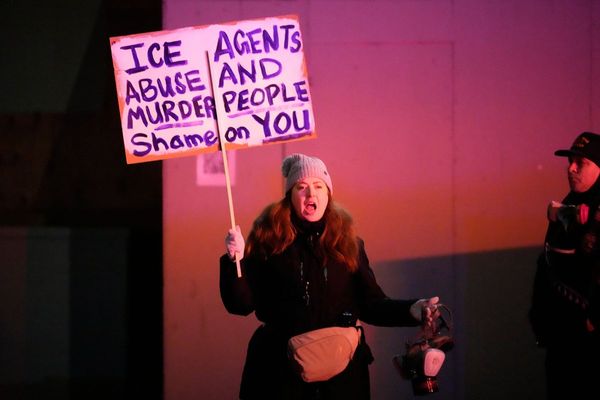
Before Kim and Kanye, Posh and Becks or Britney and Justin, there was Elvis and Priscilla.
Priscilla, Sofia Coppola’s Hollywood biopic – an official selection at the Venice film festival and soon to be released in the UK – tells the story of the first couple of 1960s America from the young Mrs Presley’s perspective. Priscilla Beaulieu, a 14-year-old schoolgirl when she met Elvis, spent the early years of their relationship partying with the most famous man in the US at night before putting on her uniform to attend Catholic high school during the day.
A stark cinematic portrait of an uneven marriage shows how Elvis used fashion as a tool to control Priscilla, moulding his wife into a feminine mirror image of himself to craft their public image as a perfect couple. Priscilla’s light brown hair, first seen in a ponytail, is dyed black at Elvis’s direction to match his own. Next, it is piled into a beehive that echos the height of his signature quiff.
“That dress doesn’t suit you,” Elvis tells Priscilla coldly when she chooses an understated earth-toned outfit in a boutique. “You’re a small girl. You’ve gotta keep away from the prints, baby.” He buys her a baby-blue, wasp-waisted dress, telling her that she can’t wear brown because it reminds him of the army.

As the wife of a global heart-throb, Priscilla was envied by millions, but the film depicts her as a woman struggling to assert her identity. Coppola has described her screenplay, based on Priscilla’s 1985 memoir Elvis and Me, as a love story. Priscilla has praised the movie, describing it as “right on” in accuracy. But Elvis’s estate, Elvis Presley Enterprises, turned down Coppola’s request for music rights, with the result that no Elvis songs appear on the soundtrack.
“The Priscilla you see on screen is Elvis’s fantasy of who she is,” says the film’s costume designer, Stacey Battat. “He had a very clear image of his ideal woman, and he projected that on to Priscilla. She lives like a queen, but he has all the power.”
In one memorable scene, Priscilla lays out dresses in a range of sugary, feminine colours on her bed. Every dress is accessorised with its own jewel-encrusted pistol in a matching shade. It is a neat visual metaphor for how clothes became a battleground in the Presley marriage. That Priscilla will eventually leave the marriage is foreshadowed, on screen, when we see her begin to push back against Elvis’s tastes, wearing blouses and trousers instead of the dresses he preferred, and swapping her signature beehive for hair worn flat and loose in a Gloria Steinem-esque centre parting.
Tamara Deverell, the film’s production designer, has called Priscilla “the story of women in North America told through hair and makeup”.
“Clothes are such an important part of storytelling,” adds Battat. “Costume design has historically been underappreciated in Hollywood, connected to the fact that it has usually been a woman’s job in a man’s industry. But Sofia values what costumes can bring to character development.”
“You know that saying – you want a whore in the bedroom, a lady in the living room? That was Elvis. Priscilla was his ideal woman, and he wanted to keep her pristine. Sexually, he went with different women altogether,” says Battat. One of the ways in which Elvis exerts control over Priscilla is by stifling her emerging sexuality, insisting his wife retain her virginal, doll-like look and refusing to have sex with her after their daughter was conceived.
But Coppola and Battat also wanted to show the romance and affection that coexisted with control and gaslighting in the suffocating atmosphere of Gracelands, the Presley’s mansion. “We know that Elvis wore reading glasses, but he never wore them in public,” says Battat. “So we showed him the way only Priscilla saw him, the graceful Southern boy she fell in love with, reading next to her in bed wearing a sweater and glasses.”

Battat created 120 looks worn by Priscilla, played by Cailee Spaeny. The film was shot in just 30 days, but the story spans 13 years and “the silhouette is super important in giving a sense of that timeline,” says Battat. “For the first part of the film, she’s wearing a crinoline under her pleated skirts. Women still wear pleated skirts now – what makes a pleated skirt look like the 1950s is having that fullness from a crinoline worn underneath.”
Historical accuracy was balanced with “pieces that resonate now, so that it’s not too jarring to the modern eye”, she says. “So the heart necklace that Priscilla wears on screen is a piece she wore that is also something girls would wear now, so we made it more prominent, because it’s so relatable, and that works.”
A Coppola film is a fashion moment as well as a cinematic one. Her 1999 debut, The Virgin Suicides, conjured a gauzy, girlish dreamscape that has reverberated through popular culture ever since. Coppola said that she wanted the Graceland interiors to feel “like wedding cake” on screen, and cited William Eggleston’s 1984 photographs of Graceland – with their unsettling close focus on swagged and saccharine velvet drapes and bloated soft furnishings – as a visual reference.
Most of the costumes were made in-house, but Chanel, for whom Coppola is a long-term ambassador, created a bespoke white lace wedding dress for Spaeny, based on photographs of the Presleys’ 1967 wedding.
Battat says the process of making the film – which ends with 28-year-old Priscilla resolving to divorce Elvis – left her “astounded by Priscilla’s strength”.
“I can’t imagine how brave she must have been, to find it in herself to walk away from all that.”
Priscilla opens in the UK on 1 January and in Australia on 18 January.







